Fascinating wildlife and animals in Kenya
Fascinating wildlife and animals in Kenya
An incredible 25% of the world’s biodiversity is found in Africa—and Kenya is one of the most biodiverse countries on the continent. According to recent estimates, Kenya is home to 25,000 animal species, including many large mammals, 7,000 plant species, and 2,000 fungi and bacteria species.
These species thrive in Kenya’s rich array of ecosystems, from lush forests and savannahs to the snow-capped peaks of Mount Kenya and arid scrublands. There are also plenty of aquatic habitats in Kenya, both along the coast and inland. Kenya is home to 467 inland lake and wetland habitats.
Unfortunately, many of these habitats—and the animals that call them home—are under threat. That’s why IFAW is supporting wildlife conservation in Kenya, working with local partners and communities to help animals and people thrive together.
We support one of Kenya’s first all-women wildlife ranger units—Team Lioness—enabling them to protect animals and communities. We’re combating wildlife crime and safeguarding ecosystems along Kenya’s coastline.
Ready to meet some incredible species? Let’s take a look at 20 of the most amazing animals you can find in Kenya.
20 of the most fascinating animals in Kenya
1. Cheetahs
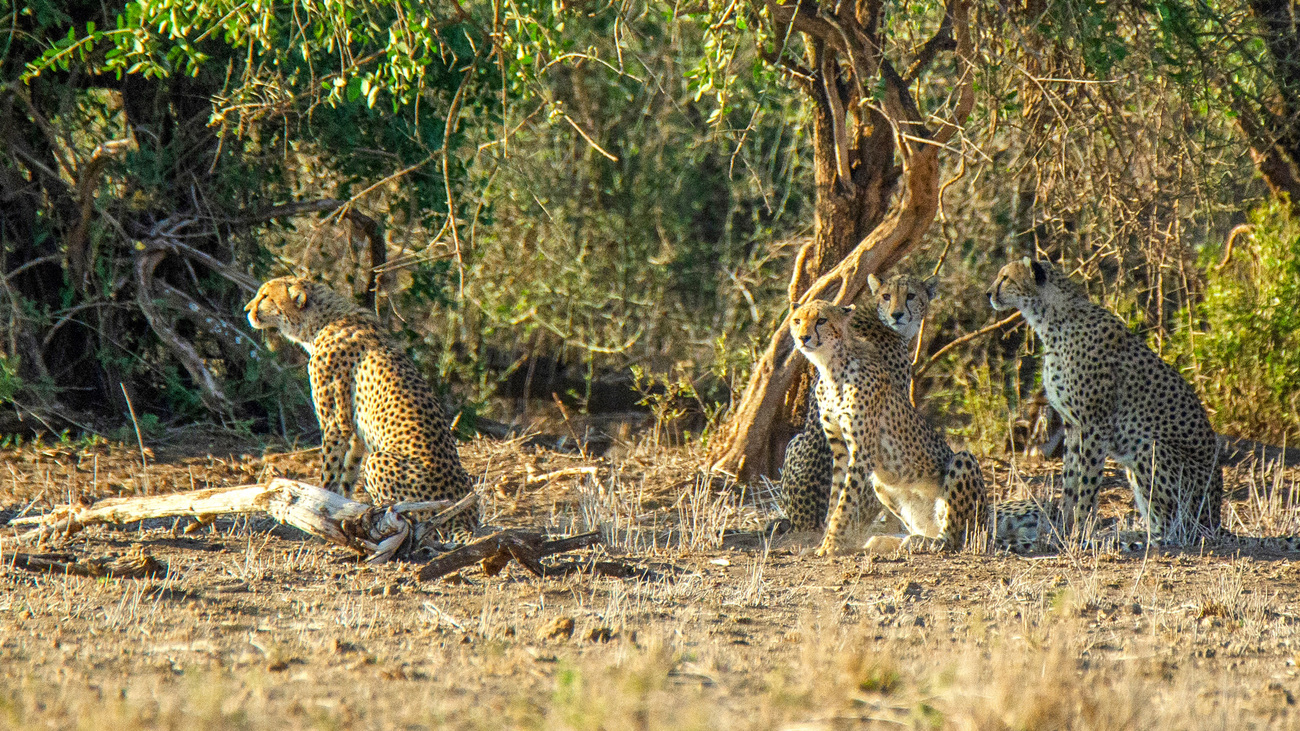
One of the most recognizable animals in Kenya is the cheetah (Acinonyx jubatus). These spotty cats—each with their own unique patterns—are skilled hunters, in part because of their natural speed and agility. In fact, cheetahs are the fastest mammals on earth. They can accelerate from zero to 60 miles per hour in just three seconds. Another interesting cheetah fact? Unlike lions, tigers, jaguars, and leopards, cheetahs can’t roar—they can only purr.
These cats live and hunt in open grasslands across Africa. They can be found in countries including Kenya, Algeria, South Africa, and Niger.
The International Union for the Conservation of Nature (IUCN) classifies cheetahs as vulnerable. This means the species is at high risk of extinction in the wild. In 2025, there are only about 6,517 mature cheetahs left in the wild, and their population is decreasing.
Cheetahs are at particular risk from habitat loss because they need such a large range. Most cheetahs live in unprotected areas, where they come into conflict with farmers. They are also threatened by the illegal wildlife trade.
Here at IFAW, we’re working to combat the illegal trade of live cheetah cubs, which are taken from the wild and sold as exotic pets. We’re working with several Wildlife Enforcement Networks (WENs), creating a joint response that makes cheetah welfare a priority and stops traffickers in their tracks.
2. African savannah elephants
The African savannah elephant (Loxodonta africana) is the world’s largest land mammal. It lives across many different habitats, including open savannahs, deserts, and forests. As these animals roam, they play an important role within their ecosystems. They disperse seeds through their dung, helping to fertilize the land; they clear paths through vegetation and overgrown bush, promoting plant diversity; and they use their tusks and feet to access water in dry riverbeds, creating small watering holes for other animals.
African savannah elephants are found in 23 countries across Africa. They have large populations in Kenya, Botswana, Namibia, Tanzania, South Africa, Zambia, and Zimbabwe.
The IUCN classifies the African savannah elephant as endangered. This means it is at a very high risk of extinction in the wild. Their numbers are also decreasing. One survey showed that, from 2006 to 2016, the African savannah elephant population declined by 30%.
These elephants are poached for their ivory and their natural habitats are being converted into agricultural land and infrastructure by expanding human populations. They also face human-wildlife conflict in Kenya and beyond.
IFAW is working to protect African savannah elephants and conserve their remaining habitat through our Room to Roam initiative. We’re creating new wildlife corridors that allow elephants to roam freely throughout East and Southern Africa, making populations more resilient to climate change and helping to protect the species from further decline.
3. Black-backed jackals
The black-backed jackal (Lupulella mesomelas) is a member of the dog family. It has a rusty red coat with a black patch on its back and a black-tipped tail. It measures up to 95 centimeters (37 inches) from head to tail.
As opportunistic omnivores, jackals eat what they can. They work in family packs to hunt small antelopes, but they’ll also feed on reptiles, insects, birds, fruits, berries, and carcasses left by larger predators.
There are two distinct populations of black-backed jackals in Africa—one in East Africa, in countries including Kenya, Ethiopia, and Tanzania, and one in southern Africa, in countries including Namibia, Angola, and South Africa.
These animals live in a wide variety of habitats, from deserts to grasslands to savannahs. The IUCN lists black-backed jackals as least concern, meaning they face few threats and have a stable population. However, they are hunted by farmers who kill them to protect their livestock.
4. Bat-eared foxes
The bat-eared fox (Otocyon megalotis) is another Kenyan animal that belongs to the dog family. Its large ears are its defining characteristic. It also feeds on insects like termites, lives alone or in small groups, and has six more teeth than other foxes.
The bat-eared fox can be found in savannahs, arid scrublands, and grassy plains. It lives in countries including Kenya, Tanzania, South Africa, Angola, and Zimbabwe. The IUCN lists the bat-eared fox as least concern in 2025 and as having a stable population, though they are threatened by hunters, disease, and drought.
5. Dik-diks
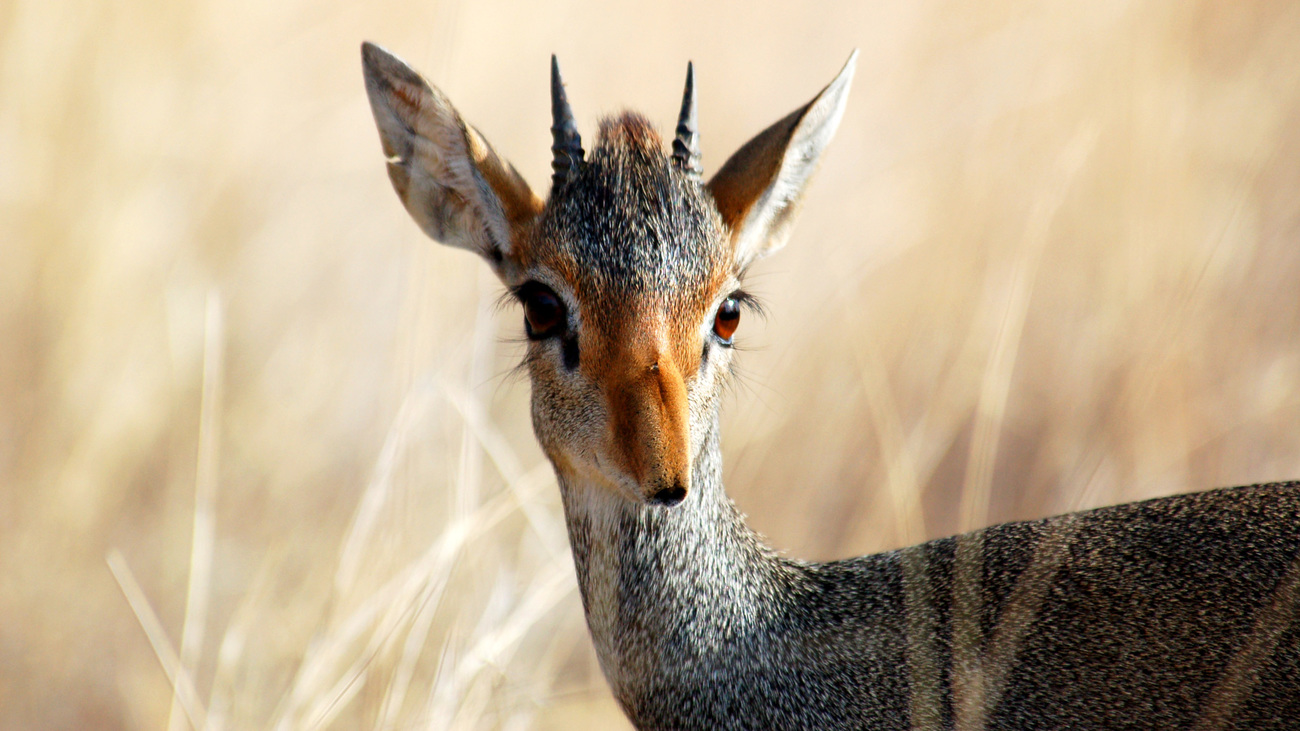
The dik-dik is a type of dwarf antelope that lives in arid regions of East Africa. They can live in such barren environments because they get water from the vegetation they eat. They also take cover in undergrowth to protect themselves from predators, including eagles and cats.
There are four species of dik-diks, but just two of them live in Kenya. These include Guenther’s dik-dik (Madoqua guentheri) and Kirk’s dik-dik (Madoqua kirkii).
Kirk’s is the largest dik-dik, though it’s still small in comparison to other antelopes. It stands at just 45 centimeters (18 inches) tall and weighs up to 7.2 kilograms (15.8 pounds). Guenther’s dik-dik is smaller but has a longer snout.
The IUCN lists both Kirk’s dik-dik and Guenther’s dik-dik as least concern with stable populations, though they are threatened by expanding agricultural settlements and excessive hunting in some areas.
6. Hyenas
There are two species of hyena in Kenya—the striped hyena (Hyaena hyaena) and the spotted hyena (Crocuta crocuta). They can be found throughout Africa, in all habitats except rainforests.
The spotted hyena (also called the laughing hyena) is the largest hyena species, with the females being larger than the males. Their coats are patterned with dark spots. These animals hunt fish, birds, and even hippo calves, and can work in packs to take down wildebeests or antelopes.
Striped hyenas are lesser known than their spotted cousins. They are more scavengers than hunters and typically come out at night to feed on carcasses left by other animals.
The spotted hyena is listed by the IUCN as least concern but it has a decreasing population. The striped hyena is near threatened. It has a decreasing population, with only 5,000 to 10,000 mature individuals left in the wild. Human-wildlife conflict is the main threat to their survival.
7. White-bellied go-away birds
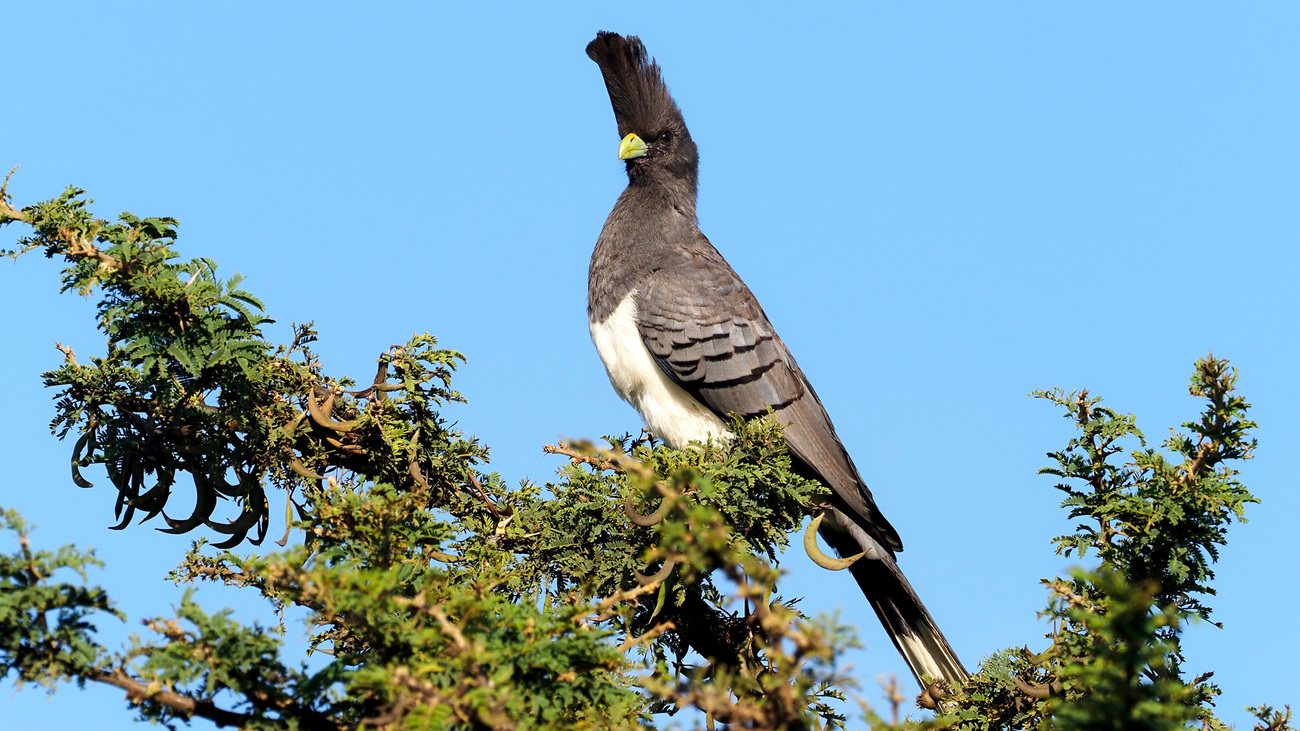
The white-bellied go-away bird (Criniferoides leucogaster) has a call that sounds like ‘go-way’. It has grey plumage, a white belly, and a huge crest on the top of its head. It also has white marks on its tail, which are visible when the bird is in flight.
White-bellied go-away birds live in the arid savannahs and woodlands of Kenya, Tanzania, Uganda, Sudan, South Sudan, Somalia, and Ethiopia. The IUCN lists this bird at least concern, with no major threats to its survival.
8. Rufous sengi
Also known as elephant shrews, there are around 20 different species of sengis. These animals are about the size of a rat and are named after their long, flexible snouts, which they use to turn over leaves and soil while they search for prey.
The rufous sengi (Elephantulus rufescens) hops around on long legs like a rabbit and has a long scaly tail. It eats ants, termites, other small insects, and earthworms in its savannah and grassland habitats. Rufous sengis are found throughout Kenya, Tanzania, Somalia, Ethiopia, South Sudan, and Uganda. They’re listed by the IUCN as least concern and as having a stable population.
9. Dugongs
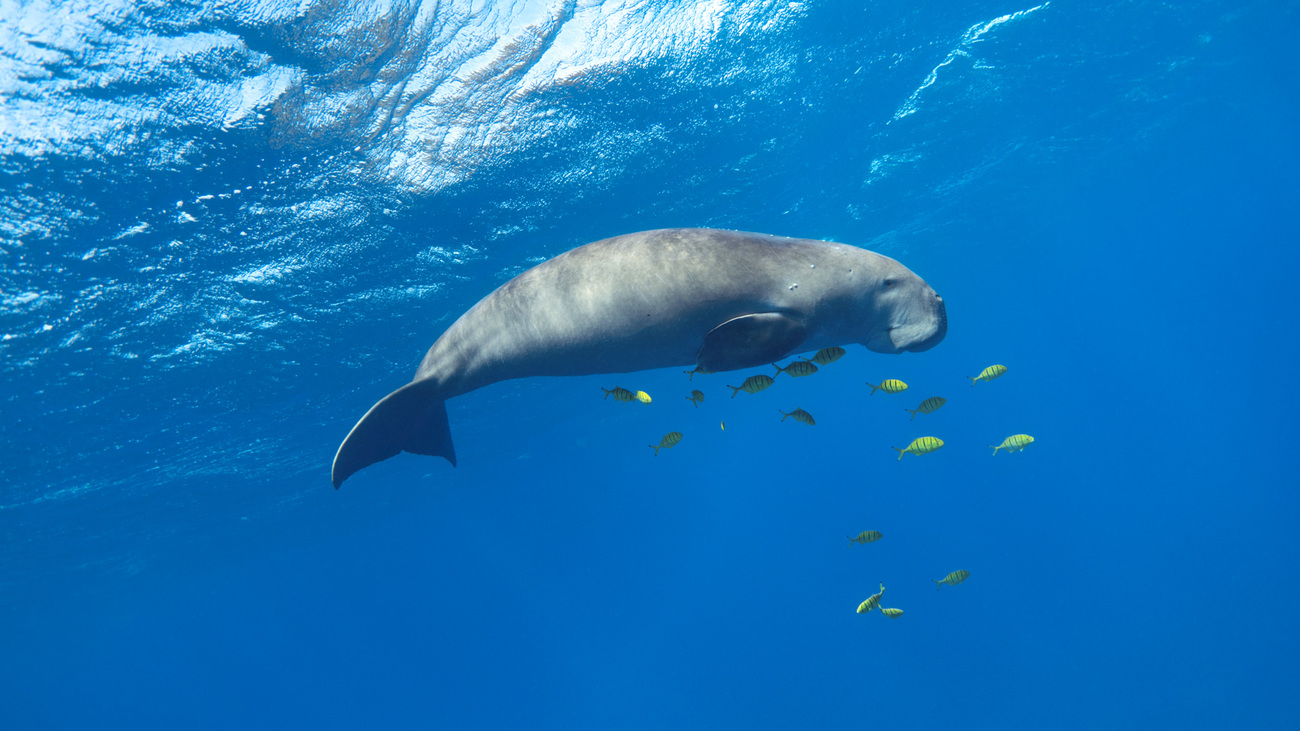
The dugong (Dugong dugon) is a marine mammal that lives off the coast of East Africa, Asia, and Australia. These large animals can measure up to 3.4 meters (11 feet) in length and weigh up to 420 kilograms (925 pounds).
Dugongs are related to manatees and are similar in appearance. They have large, sensitive snouts that they use to graze on underwater grasses. Dugongs can dive as deep as 37 meters (120 feet) and they can hold their breath for up to six minutes. They have extremely long lifespans, with some individuals living until they’re 73 years old.
According to the IUCN, dugongs are vulnerable with a decreasing population, and at high risk of extinction in the wild. They are threatened by boat strikes, entanglement in fishing gear, and illegal hunting.
IFAW is working to protect dugongs living off Kenya’s coastline. We recently helped conduct an aerial survey to map out the population of dugongs and identify threats to their survival. We’re also dedicated to reducing ocean noise pollution across the globe. Ocean noise interferes with dugongs’ ability to communicate, attract a mate, and even feed.
10. Desert warthogs
The desert warthog (Phacochoerus aethiopicus) is a member of the pig family. It has a large, warty head, a coarse mane, and two pairs of tusks. Unlike the common warthog (Phacochoerus africanus), which can be found across most of Africa, the desert warthog only lives in Kenya, Ethiopia, and Somalia. It lives in savannah and shrubland habitats, where it feeds on grass and other vegetation and uses abandoned aardvark burrows as a place to shelter.
The desert warthog is listed by the IUCN as least concern in 2025 with a declining population. This is partly because the species experiences high mortality in central Kenya during dry periods. Other risks include growing human and livestock numbers, which increase competition for both water and food. Warthogs are also victims of poaching—they are hunted for their bushmeat and tusks.
IFAW is involved in several conservation efforts that benefit warthogs and other wildlife. Our work involves community engagement to help former poachers earn income from alternative livelihoods, such as sustainable farming. We’re also helping elephants thrive in their role as ecosystem engineers, which supports the maintenance of healthy habitats for animals across Africa.
11. African jacanas
The African jacana (Actophilornis africanus) is a water bird. It has a chestnut-coloured body, a black and white head and neck, and a bright blue beak. Its enormous feet are another distinguishing feature. The African jacana uses its long claws and toes to walk across water lilies and other aquatic vegetation.
These birds live in the shallow lakes and wetlands of sub-Saharan Africa. They’re widespread, ranging as far west as Mauritania, as far north as Mali, as far east as Kenya, and as far south as South Africa.
The IUCN classifies the African jacana as least concern and with a stable population. There are thought to be around 667,000 mature individuals in the wild in 2025. However, degradation, flooding, draining, and overgrazing of their habitat impact the bird’s ability to thrive.
12. Zebras
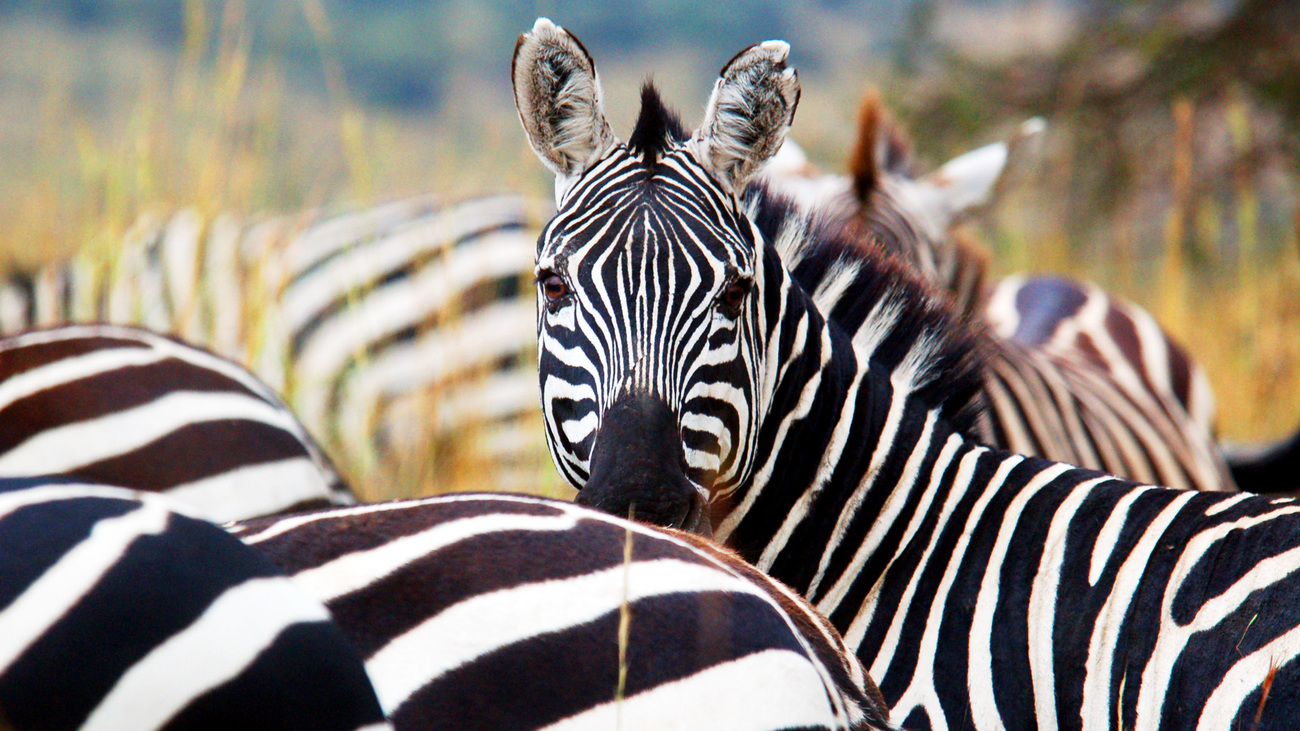
There are two species of zebras living in Kenya—the plains zebra (Equus quagga) and Grevy’s zebra (Equus grevyi). The plains zebra lives in grasslands across East and southern Africa, while Grevy’s zebra lives in arid and sparsely wooded areas in Kenya and Ethiopia.
You can tell these zebra species apart by looking at their black and white striped patterns. Plains zebras generally have wide stripes with wide spaces between them. They may also have shadow stripes (lighter-coloured stripes) between the main stripes. Grevy’s zebras, on the other hand, have narrow and closely-spaced stripes, along with a white belly. They also have a chevron on their rumps where their stripes meet.
The IUCN lists the plains zebra as near threatened. This means it is likely to become a threatened species in the near future. The plains zebra has a decreasing population with between 150,000 and 250,000 mature individuals left in the wild.
Grevy’s zebra is listed as endangered. In 2025, there are thought to be just 1,956 mature individuals left in the wild, compared to 13,700 in Kenya alone 50 years ago. The main threats to its survival include habitat degradation and competition from grazing livestock.
At IFAW, we support Grevy’s Zebra Trust (GZT), the only organization in the world focused entirely on conserving this species in Kenya. We’ve also supported zebra populations elsewhere in Africa, reintroducing zebras and other animals into Kasungu National Park, which was decimated by decades of severe poaching.
13. Thomson’s gazelles
Thomson’s gazelle (Eudorcas thomsonii) is a small to medium-sized antelope with a sandy-brown coat, a black band across its flanks, a white belly, and a pair of powerful, ringed horns.
Thomson’s gazelles live exclusively in East Africa, in the savannahs and grasslands of Kenya and Tanzania. Here, in herds, they feed on grasses, shoots, and leaves. They are preyed on by cheetahs, lions, and wild dogs. When under attack, Thomson’s gazelles can run extremely fast, reaching speeds of 65 kilometers (40 miles) per hour.
The IUCN lists Thomson’s gazelle as least concern, but their population is decreasing in 2025. There are around 145,000 mature individuals in the wild that face threats related to human expansion and climate change.
14. Grant’s gazelles
Grant’s gazelle (Nanger granti) is a medium-sized antelope. It has a tan or light brown coat, a white belly, and lyre-shaped horns. It lives in the savannah, grassland, and shrubland of East Africa, including in Kenya, Uganda, and Tanzania.
Grant’s gazelles are larger than Thomson’s gazelles. Males weigh 45 to 65 kilograms (100 to145 pounds) and measure up to 166 centimeters (5.5. feet) tip to tail.
According to the IUCN, Grant’s gazelle is classed as least concern. However, it’s important to note that their numbers are declining over large parts of their range due to hunting, drought, and human expansion.
15. Gerenuks
Gerenuk (Litocranius walleri) means ‘giraffe-necked’ in Somali, and this antelope has the longest neck of any gazelle. This—along with an ability to stand on its hind legs—helps the gerenuk eat leaves that are out of the reach of other antelopes. It lives in the arid savannah and shrubland of the Horn of Africa in countries including Kenya, Somalia, Ethiopia, and Tanzania.
The IUCN lists the gerenuk as near threatened with a decreasing population. Its main threat is loss of habitat to farming, though civil war in Somalia has also affected its range in recent decades.
16. Green keel-bellied lizards
The green keel-bellied lizard (Gastropholis prasina) is a medium-sized lizard that measures around 35 centimeters (13.8 inches) long, including its tail, which is huge in comparison to its body. Its most striking feature, though, is its bright coloring. Its skin is a shocking green color, while its tongue and the inside of its mouth are bright orange. It lives in small pockets of forest and woodland in Kenya and Tanzania.
The IUCN lists the green keel-bellied lizard as near threatened. Its coastal forest habitat is rapidly disappearing, as urban and agricultural development pose a major threat to forests in the region.
17. Kenya coast galagos
The Kenya coast galago (Paragalago cocos) lives in the coastal forests of Kenya and Tanzania. Also known as a bush baby, it’s a primate that spends most of its life in trees, where it eats fruit and insects. It’s a nocturnal animal and has large eyes that help it to see in the dark, as well as large ears that can rotate to pick up the sound of their prey.
According to the IUCN, the Kenya coast galago is classed as least concern. Nevertheless, its numbers are thought to be decreasing, and its habitat is being converted into farmland and plantations.
18. Mount Kenya dwarf chameleons
The Mount Kenya dwarf chameleon (Trioceros schubotzi) is only known to live on Mount Kenya, a mountain that is part of a national park in the centre of the country.
According to the IUCN, the Mount Kenya dwarf chameleon is near threatened. There is little information on how many remain, but as it lives at high altitudes where there are very few threats, it’s assumed that the population is stable. The primary threat they are thought to face is fire. Mount Kenya is a fire-prone region, and fires are likely linked to population decreases of these reptiles.
19. Kenya montane vipers
The Kenya montane viper (Montatheris hindii) lives in protected land in the Aberdare Mountains and on Mount Kenya. It lives in high altitude moorland at elevations of 2,700 to 3,800 meters (8,858 to 12,467 feet). Not much is known about the Kenya montane viper. It’s not clear whether this species is rare or just very shy. However, we do know that, like other vipers, it gives birth to two to three live young instead of laying eggs.
The IUCN lists the Kenya montane viper as near threatened. Moorland fires and large local human populations mean their habitat is at risk of disturbance and change.
20. Kenyan high-casqued chameleons
The Kenyan high-casqued chameleon (Trioceros hoehnelii) is a small to medium-sized chameleon that lives in the central and western highlands of Kenya and eastern Uganda. These cool, temperate regions have lots of vegetation, including grasses, shrubs, dense bushes, and trees. The chameleon is also sometimes found on hedges in towns and gardens, in farmland, and in heathland.
Its ability to live in such a wide variety of habitats means the Kenyan high-casqued chameleon is more resilient to habitat change. In 2025, the IUCN lists the Kenyan high-casqued chameleon as least concern with a stable population.
IFAW works to protect animals in Kenya and around the world. We rescue animals and restore habitats, helping both humans and wildlife to thrive.
Related content
Our work can’t get done without you. Please give what you can to help animals thrive.